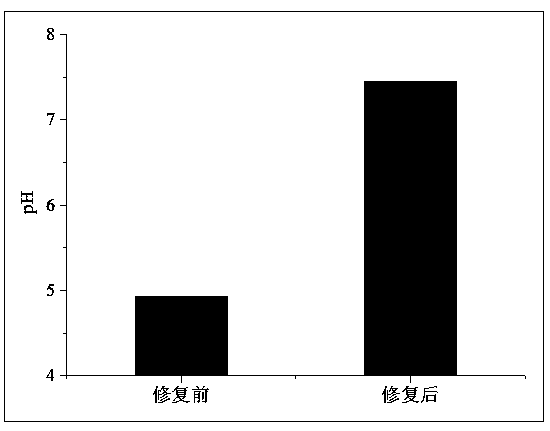Method for remedying acidified arsenic contaminated soil by biochar-loaded nano-scale zero-valent iron cooperated with bacteria
A nano-zero-valent iron and biochar technology is applied in the restoration of polluted soil, which can solve the problems of large dosage, long repair time and low repair efficiency, and achieve the effect of reducing dosage
- Summary
- Abstract
- Description
- Claims
- Application Information
AI Technical Summary
Problems solved by technology
Method used
Image
Examples
Embodiment 1
[0040] 1) Enrichment culture of bacterial strains
[0041] Pseudomonas putida P. putida Strain MnB1 was inoculated in Pseudomonas putida enrichment medium A at a volume ratio of 5%, and then aerobic enrichment culture was carried out at 25°C under horizontal shaking (150 rpm) for 2 days; the components of medium A Yeast extract 0.3g, hydrolyzed casein 0.2g, glucose 0.3g, calcium chloride 0.1g, magnesium sulfate 0.1g, trace elements 1mL, deionized water 1 liter;
[0042] The selected bacterial strains come from the American Type Bacteria Collection Center with the preservation number ATCC 23483.
[0043] 2) Preparation of active metabolites
[0044]Add the Pseudomonas putida bacterial solution enriched in step 1) to Pseudomonas putida culture medium B with a pH of 7.2 at the same time as 1.2g / L manganese carbonate at an inoculation amount of 5% by volume, and then at 25°C Cultivate under aerobic conditions for 7 days, and brown-black flocs appear in the medium, which means t...
Embodiment 2
[0054] 1) Enrichment culture of bacterial strains
[0055] Pseudomonas putida P. putida Strain MnB1 bacteria were inoculated in Pseudomonas putida enrichment medium A according to the transfer amount of 10% by volume, and the components of the medium A were yeast extract 0.8g, hydrolyzed casein 0.8g, glucose 0.8g, Calcium 0.4 g, magnesium sulfate 0.6 g, trace elements 5 mL, deionized water 1 liter, and then at 35 °C under horizontal shaking (180 rpm), aerobic enrichment culture for 5 days;
[0056] The selected bacterial strains come from the American Type Bacteria Collection Center with the preservation number ATCC 23483.
[0057] 2) Preparation of active metabolites
[0058] Add the Pseudomonas putida bacterial solution enriched in step 1) to the Pseudomonas putida culture medium B with a pH of 7.5 at the volume ratio of 10%, and add 0.8 g / L manganese carbonate at the same time. The composition of medium B is 0.45 g of ferrous ammonium sulfate, 0.5 g of sodium citrate, 0....
Embodiment 3
[0067] 1) Enrichment culture of bacterial strains
[0068] Pseudomonas putida P. putida Strain MnB1 was inoculated in Pseudomonas putida enrichment medium A at a volume ratio of 8%, and then aerobic enrichment culture was carried out at 25°C for 4 days under horizontal shaking (150 rpm);
[0069] The components of the medium A are 0.5 g of yeast extract, 0.4 g of hydrolyzed casein, 0.5 g of glucose, 0.5 g of calcium chloride, 0.4 g of magnesium sulfate, 3 mL of trace elements, and 1 liter of deionized water;
[0070] The selected bacterial strains come from the American Type Bacteria Collection Center, with the preservation number ATCC 23483;
[0071] 2) Preparation of active metabolites
[0072] Add the Pseudomonas putida bacterial solution enriched in step 1) to the Pseudomonas putida medium B with a pH of 6.8 at an inoculum volume of 6% by volume, and add 1.0g / L manganese carbonate at the same time, and then Cultivate under aerobic conditions at 30 degrees Celsius for 7 ...
PUM
 Login to View More
Login to View More Abstract
Description
Claims
Application Information
 Login to View More
Login to View More - R&D
- Intellectual Property
- Life Sciences
- Materials
- Tech Scout
- Unparalleled Data Quality
- Higher Quality Content
- 60% Fewer Hallucinations
Browse by: Latest US Patents, China's latest patents, Technical Efficacy Thesaurus, Application Domain, Technology Topic, Popular Technical Reports.
© 2025 PatSnap. All rights reserved.Legal|Privacy policy|Modern Slavery Act Transparency Statement|Sitemap|About US| Contact US: help@patsnap.com



